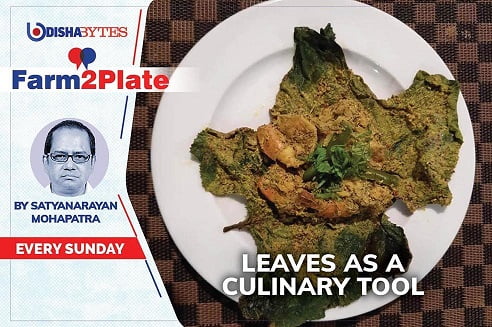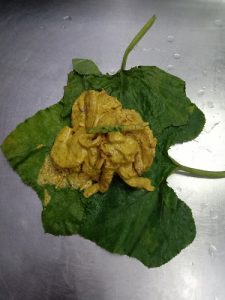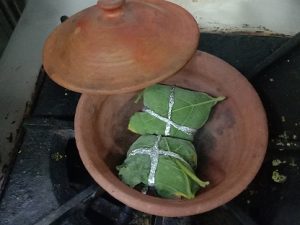Leaves As A Culinary Tool

Leaves were probably one of the earliest culinary tools. It was used to store and transfer food. Using them to then cook would have been the next step for our hunter-gatherer ancestors, who must have discovered that some leaves make a good wrapping or covering to protect foods from exposure to direct flame or heat sources.
This age-old culinary technique: by which food was wrapped in leaves and then cooked by way of roasting, grilling, frying or steaming was a natural and eco-friendly way of cooking. The leaves were a great casing that protected the food from direct heat, dirt and fluids. Most importantly, it trapped the steam and sealed in the flavours, while allowing the food to cook slowly in mellow heat with its own juices; and sometimes soaking in the flavour of the leaf as well. This process gave a unique earthy, natural flavour and literally ‘packed’ a punch when it comes to wholesome goodness.
Cooking with leaves finds favour across several tropical countries and even in the West. Usage of banana, pumpkin, bottle gourd, Colocasia, turmeric, jackfruit, teakwood and screw pine leaves are quite popular and an indispensable culinary tool for roasting, grilling or steaming in the whole of Odisha kitchens.
Cooking in leaves is popular mainly because it locks in flavour, as well as the moisture, and makes the food more palatable. The leaves themselves impart a natural, indigenous flavour to the food, making it unique and if it is cooked specially with pumpkin or bottle gourd — the best part is, you do not have to discard the leaf here, it is part of the dish.
Almost all the popular restaurants in Odisha offer one or two leaf-wrapped dish — either roasted, grilled or pan fried. But ‘The Melting Pot’ at VITS serves this leaf-wrapped dish with a very traditional and authentic recipe. The method they use is a combination of roasting and grilling done at a go; a process which is quite popular in Sri Lankan cuisine.
Chingudi Patra Poda
We caught up with Executive Chef Satyabrata Jana and he was kind enough to give a live demonstration in the kitchen of ‘The Melting Pot’. At the designated time we met and went through the whole process of preparing his signature dish ‘Chingudi Patra Poda’. The dish may sound very ordinary but what came out was unique. It was unique in all accounts — marination, usage of spice, and preparing it the rural Ceylonese (Sri Lankan) cooking method. First, Jana marinated the cleaned (patted dried with a kitchen cloth) prawns with lime juice, ginger garlic paste and salt. After 20 minutes, he squeezed out the water from the prawns. His explanation — this process helps in removing the fleeting and fish odour from the prawns. Then he powdered roasted chillies, black pepper and cumin coarsely and added them to the prawns and gave a good mix for a good five to 10 minutes. The mix was then rested and in the meantime a paste was made with white mustard, turmeric, mustard oil and yogurt. This paste was added to the prawns and given a good massage for about two to three minutes.
The masala-coated prawns were then securely wrapped in bottle gourd leaves (soaked in warm water for softening them), tied with a string and placed in a terracotta hopper pan. The chef has improvised himself and this process helps trap the earthy and burnt leafy flavours in the prawns. This is a process he has adopted from the rural areas of Sri Lanka. Alternatively, he suggests one can also roast it in a pan with some mustard oil. The advantage of making this dish with bottle gourd or pumpkin leaves and even Colocasia leaves, all of which are edible — double fun.
After being on a simmering fire for a good 20 minutes, the dish was ready to be devoured by either uncovering the leaf to get the prawns out or just slicing a piece of the wrap and putting it straight to the mouth. As bottle gourd leaves were used, there was no need to discard the leaf. The prawn just melted in the mouth due to the first marination with lime juice and the yogurt in the mustard paste, which helped change the structure of the proteins in the fish, essentially “cooking” the fish without using high heat as required for other meat.
Chef suggestion: if one is allergic to crustaceans and seafood then one can use seasonal fresh water fish — hilsa, rohu and bhekti also. Finally, the usage of mustard and chillies should be used as per sensitivity, pungency and heat tolerance.


For the road
This dish seems a distant cousin of the Parsi dish, ‘Patrani Machhi’, which again literally means fish cooked in a leaf. The cooking process is identical where you wrap slices of fish or even whole fish in banana leaf and prepare it. The difference is in the fish and spices used. ‘Patrani machi’ is typically made from Pomfret, a sea fish, and the spice is a mix of coriander and mint leaves along with grated coconut and ginger-garlic-onion paste.
Many other international cuisines also use the same technique.
South East Asia: A version of fish cooked in ‘Plantain leaves’. The fish is typically halibut or cod and the spices are chopped garlic, crushed pepper and salt smeared with olive oil. They seem to use banana leaves extensively to cook sticky rice as well.
Mexico: Use of banana leaves to parcel and cook simple dish like tamale (made from corn starch dough) to elaborate recipe like whole suckling pig.
Thus, it seems that across tropical countries, wherever there has been an abundance of banana plantations, locals have learnt to use it as a cooking medium.

Comments are closed.